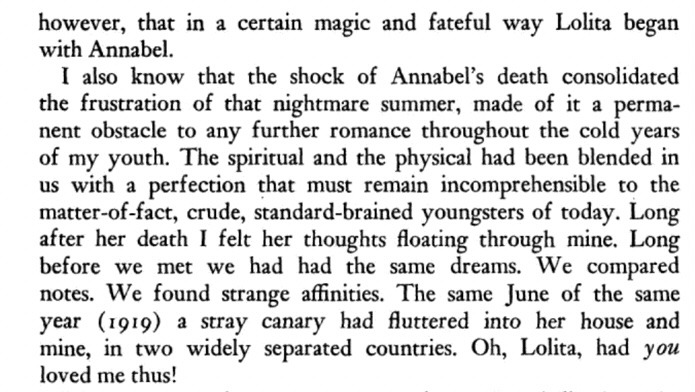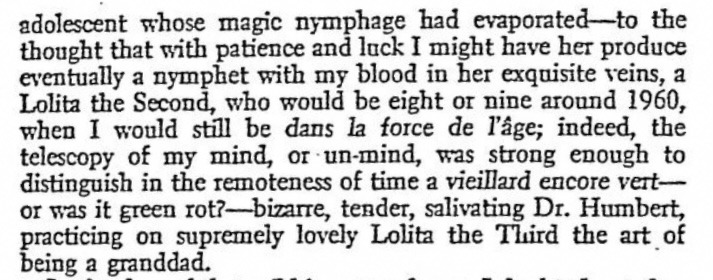Lolita and The Locked Tomb

Not much of a journal entry...Not quite to the quality of an article or essay either...A lot of rambling, jumping, and carrying-on will occur here. I guess this is mostly just a big ongoing stream of thoughts vaguely connected, and I doubt many (if anyone) will read this due to its relatively niche nature but i still wanted to get it out of my system. I want to preface this with a strong warning for mentions of abuse, incest, rape, and csa as those topics are present throughout.
I finished Lolita by Vladimir Nabokov the other day and i can say with certainty it is unlike anything i've ever read before and it's probably the fastest i have burnt through a book. I genuinely can't sing my praises high enough. It's disturbing, funny, thought-provoking... it's just good. It's definitely one of my favorites. What motivated me to read Lolita was actually The Locked Tomb which i'd heard drew upon it but i had never taken a look for myself. I'd been planning to read Lolita for a while so i felt it was time i finally cracked it open and i am so deeply glad i did.
I am going to assume if you're here you've read either The Locked Tomb or Lolita. It's a bit hard to condense the 3 books of The Locked Tomb series into a cohesive summary so i fear this won't be very comprehensible to any non-tombheads. However, for Lolita I would think you have at least a vague idea of the novel from cultural osmosis, but just in case i do have a nice little sparknotes summary if you are yet to read it. Anyway, while reading Lolita i found myself really entranced by the connections present between Dolores Haze/Humbert Humbert and Kiriona Gaia/John Gaius in The Locked Tomb.
On the first few pages of Humberts recollection of his childhood we're introduced to Annabel Leigh-- a girl he fell in love with at thirteen who later died of typhus...if you've read The Locked Tomb that probably sounds familiar as Annabel Lee is what John often calls Alecto, both are of course allusions to Edgar Allan Poe's "Annabel Lee". Humbert is fascinated with Annabel and wishes to capture that same romance with another "nymphet", essentially using her as the framework which he bases his desire off of.


John follows a similar line of thought, where the entire basis of cavaliership is founded on the blueprint of his and Alectos relationship as she was the first cavalier, with all necromancer and cavalier pairs essentially being a parody of that first dynamic, in the same vain that all "Nymphets" and "Lolitas" of humberts life began with Annabel, and are attempts at a replication of their relationship.

It should be noted, also, with both novels having their own respective Annabels that they of course have their vessels where Annabel is projected onto. Enter Dolores Haze and Kiriona Gaia. I think it gets especially interesting here, because just as Dolores is put in comparison to Annabel, Gideon has a parade of paralells to Alecto behind her and, essentially, takes the role of Alecto in relation to John as she becomes his cavalier just as Alecto was. Cavaliership in tomb is very importantly a shorthand for many things, but particularly marriage is a big one ("one flesh one end" being a reference to Mark 10:6 - 8, the constant use of the book of Ruth which is often included in lesbian weddings, C- and N- getting married and resurrected as cavalier and necromancer, the general fact that both marriage and cavaliership is an idealized ritual secured with a vow, and this is just a few...i could go on.) Along with this view of cavaliership, there is also the general loss of autonomy both bodily or otherwise that is inherent to the position of cavalier.
This loss of autonomy, especially bodily, can be seen time and time again. Of course theres Kiriona as made into a construct and indestructable weapon of empire, Naberius both eaten by and having his corpse puppeted by Ianthe, everything about Colum and Silus. You get the picture. This idea of normalized violation or general power over another person pretty obviously makes the cav/necro dynamic a stand-in for abuse, which combined with loss of agency and bodily violation of an unconsenting (in this case, typically dead) person can be read as being evocative of rape. Going forward, both the marriage and sexual violence connections made to cavaliership will be used. I could go further into this but i would probably start writing on an entirely different tangent, but either way it's important to bring up when talking about the connections between both novels.
I mention the cavaliership as marriage thing in specific primarily because I think that this when paired with the reanimation of Kiriona lends to an interpretation of an emblematically incestuous relationship between her and John which, of course, calls to mind Lolita and the inherent violence in the relationship between Humbert and Dolores as "father" and "daughter". I must specify I am absolutely not Literally arguing that John and Kiriona's relationship is at all incestuous, because that is something extremely easy to disprove and has zero backing, but rather that a non-literal reading of their relationship in that manner fits into both prior instances of cav/necro relationships as representing forms of abuse we have seen before/generally abuse as an overarching theme in The Locked Tomb and the abuse in Lolita which Muir alludes to.
I think something similarly interesting about the connections between Dolores and Kiriona is when it comes to them being treated as or compared to dolls and given inhuman quality. With Dolores its littered all throughout the book-- she's Dolly, the Haze house compared to a dollhouse, the way she's dressed up by Humbert as if she's a doll, Dolores as someone Humbert desires as a concept but not as a person, compared to a demon by way of how Humbert views "nymphets", etc. For Kiriona, a similar doll metaphor is used as she is represented by a doll, (Bride's dream Midge in specific as contrasted to the favored Barbie, also notable is that the concept of the daughter-bride recurs here.), made into an unkillable weapon of empire, dressed up in luitenants garb, literally Used as Bait For Harrow, etc.
There's also the fact that Kiriona is an heir to John, which is interesting in the sense of Kiriona being sort of a "way out" for him. The entire idea of immortality is present throughout Lolita as Humbert attempts to eternally preserve Annabel through the "nymphets" he encounters and with Dolores in particular, achieving a sense of immortality through his manuscript, and of course the desire to have children as a continual lineage is a form of immortality in itself both for him and Annabel. Likewise in The Locked Tomb, John's immortality is secured through Kiriona even if he were to "die" by virtue of her being his heir, in fact much like Humberts idea of immortality through the preservation of Annabel in his victims, Alecto is preserved through the continuation of a necromancer/cavalier bond. I feel this also speaks to the idea of the repitition of abuse and the way that abuse is often cyclical-- cavaliership is based off of a failed and unhealthy dynamic and continues to be based off of this failed system the same way that Humbert desires to continually base his relationships with his "nymphets" on the unfulfilled tryst with the late Annabel.

At this point i'm getting kind of tired of writing and I feel i've said for the most part everything that I have to say that is, like, somewhat reasonably backed up or worth saying, because i could really go on for a while about how The Locked Tomb relates to and takes inspiration from Lolita. It really expands beyond just John and Kiriona although they bear the brunt of it, I think it's something really present too with Harrow and John but i can't really say that with confidence in the Specifics of the whole John-Humbert thing.
I guess what i'm getting at here is that John and Harrow have that similar imbalanced father/daughter type relationship-- John literally says as much to her face that he wishes for her to be his daughter, plus whatever the J+E, J+A, J+H scene was, and of course the way John manipulates Harrow throughout HtN + the whole... mentor thing. Him projecting onto Harrow... Harrow like Kiriona being apart of that continuation of Alecto of course in the same way Dolores is a continuation of Annabel...(vague hand gestures). And so i'm really excited to see the way their dynamic unfolds with all of this in mind and how it may relate to this because it is sooo fun to think about.
Also honorable mentions to 1. the scene where Ianthe and Coronabeth reunite which felt really similar to when Humbert and Dolores reunited and he starts bitch crying...ill die if you touch me... and she's consoling him like ohhh no dont cry...ahh...hey its okay honey... that whole thing. I remember reading it and i was like oh this feels familiar...and it was! and 2. Both Lolita and The Locked Tomb draw upon Mary Shelley's Frankenstein and Miguel de Cervantes Don Quixote. Some day i will write my big 100000000000000 word essay connecting all of these books and you will all be sorry.
I think also outside of Tomb just reading Lolita was really really cathartic. I've heard a lot of fellow CSA victims who feel very offended by Lolita and i think those feelings make total sense, but for me personally as someone who really felt i was Dolores it very much spoke to the struggles i was facing at her age, and for that reason it's just a really valuable book to me. I feel very seen, and i do think the book deserves to be talked about, because i think people have a very warped idea of the novel in their minds thats colored by the aestheticization of Lolita in pop culture. It's absolutely not a book for everybody, but if you can stomach the subject matter i do think it is incredibly worth it
Thanks so much for reading if you've gotten this far! It really means a lot to me. I'm terrible at writing long-form stuff and articulating my thoughts and i'm positive somebody out there has expressed what i've said here in much better detail and cohesion but i'm still glad to have done it.
